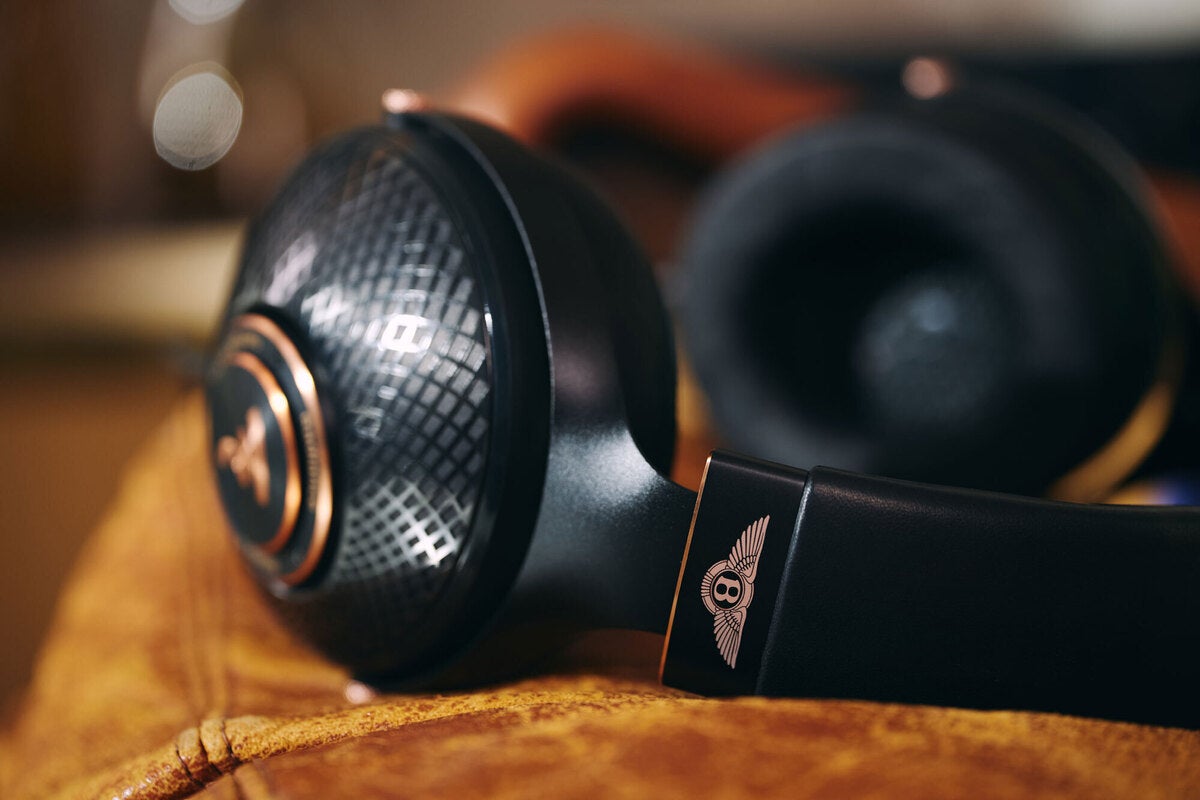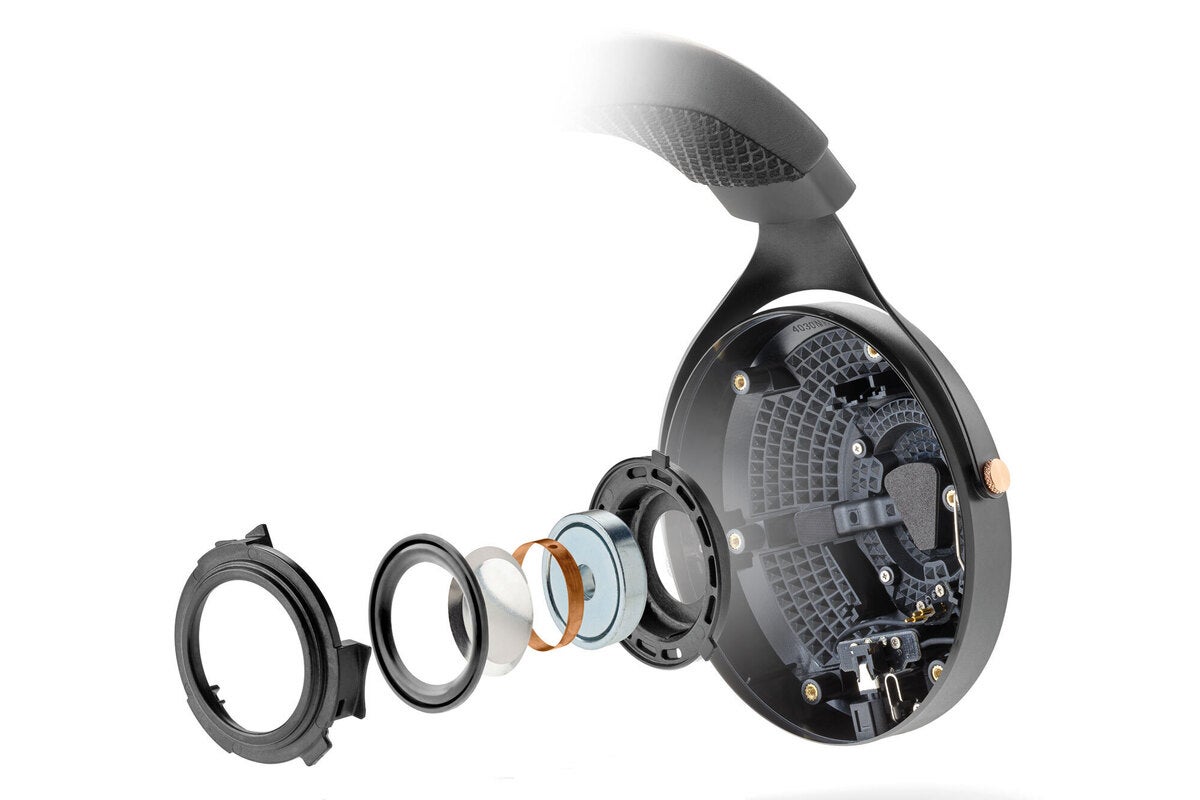 Credit: Focal
Credit: Focal
Focal produces some of the best headphones in the world, with prices to match. Bentley holds a similar position in the automotive industry, and Focal’s sibling company, Naim—also a well-respected luminary in high-end audio—has been supplying sound systems for Bentley cars since 2008. So, it’s no surprise that Focal and Bentley have teamed up to bring a new headphone into the light of day: the Radiance.
At $1,299, the new model sits squarely between Focal’s Elegia ($899) and Stellia ($2,990), deriving features from both. Soundwise, it’s a bit different than its siblings, but still excellent.
This review is part of TechHive’s coverage of the best headphones, where you’ll find reviews of competing products, plus a buyer’s guide to the features you should consider when shopping for this type of product.
Features
Like the Elegia and Stellia, the Radiance is a circumaural (around-the-ear), closed-back design that connects to the source device with actual wires—no Bluetooth here! It comes with a 4-foot OFC (oxygen-free copper) 24 AWG cable with a 3.5mm plug and an adapter that converts it to a 1/4-inch plug. The design elements are pure Bentley, with the company’s logo at the ends of the headband, a diamond motif in the outer earcup grilles and the stitching of inner headband that’s reminiscent of Bentley’s iconic upholstery quilting, and an elegant black-and-copper color scheme. Also notable is the full-grain Pittards leather that covers the earpads and inner headband.
 Focal
Focal
Focal designed its Radiance headphone in cooperation with the luxury automobile manufacturer Bentley Motors.
The full-range driver is the same one found in the Elegia—a 40mm M-shaped dome made from an alloy of aluminum and magnesium. (The driver in the Stellia is the same size and shape, but it’s made from pure beryllium.) Why is it called “M-shaped”? The cross section of the diaphragm resembles the letter M, which is said to offer high rigidity for more precision and less distortion. Specs include a frequency response from 5Hz to 23kHz (no tolerance given) with a THD of 0.1 percent @ 1kHz/100 dB SPL and a sensitivity of 101 dB SPL/1 mW @ 1 kHz. The impedance is 35 ohms, making the Radiance relatively easy to drive.
As in the Elegia and Stellia, the earcups offer excellent isolation from ambient sound while providing an optimized acoustic environment for the drivers. In fact, the earcups include two vents: one to control the balance between the bass and midrange and the other to evacuate the rear wave from the center of the motor to avoid compression and extend the low-frequency response—in other words, this is a bass-reflex headphone! At the other end of the sonic spectrum, EVA (ethylene-vinyl acetate) foam behind the drivers absorbs excess high-frequency energy. Finally, acoustic diffusers break up any standing waves and make the earcups more rigid and inert.
 Focal
Focal
Viewed in cross section, the driver diaphragm resembles an “M,” which Focal says improves its rigidity.
While the earcups use the same design, Focal took a different approach in the tuning of the Radiance. According to the company, the new headphone has more bass and a bit more treble—apparently, the classic “smile” EQ curve—and it’s warmer than the Elegia. Also, it is said to have very wide dynamic range.
As I said in my Stellia review, even the packaging is noteworthy. A large, sturdy box includes the headphone and cable in their rigid, woven-cover case that, in this instance, sparkles with copper and black threads, and the Bentley logo adorns the handle.
 Focal
Focal
Even the packaging is quite impressive.
Performance
Putting the Radiance on my head, it felt identical to the Stellia—same large earpads that fit easily over my large ears, good acoustic seal, and low clamping pressure. And the leather earpads were super comfortable.
As usual, I listened to tracks from Tidal’s Master high-res audio library playing from my iPhone XS through an iFi hip-dac, reviewed here. Also as usual these days, I started with a track from the amazing Jacob Collier—in this case, his cover of the Police classic “Every Little Thing She Does” from Djesse Vol. 1. Right away, I noticed bright highs and deep bass that was a bit overdone, especially the low piano note at the end, though the rest of the bass seemed slightly too forward as well. On the other hand, the vocals were very clear and present, and the overall sound was smooth and well-integrated.
A new discovery for me is Artemis, a seven-member, all-female, modern-jazz ensemble consisting of a rhythm section and several horns. “Goddess of the Hunt” from the group’s eponymous album features some wonderfully inventive composing, arranging, and improvising. On the Radiance, the bass was slightly overbalanced, but the horn section was clear, and the soloists emerged nicely.
 Focal
Focal
The earcup and driver are carefully designed to deliver excellent sound quality.
For some more straight-ahead jazz, I turned to Diana Krall’s new album The Dream of You. Her rendition of “That’s All” is a simple quartet of piano, guitar, acoustic bass, and drums accompanying her wonderful voice. The Radiance produced a clean, clear sound with her vocal way up front, which is probably in the mix. The bass was slightly overbearing, and the piano was just a tad congested in the low end.
Turning to some rock, I cued up “Sex Shooter” from Prince’s posthumous album Originals. In this case, the vocals were somewhat farther back than I had heard up to now, while the synthesizer was more up front. Interestingly, the synth bass was not overbalanced, though the kick drum was pretty dominant. Overall, the sound was clean and clear.
As I was looking around the Tidal Master library, I came across an artist called Mozart La Para, so I listened to “Golpe De Estado” from the album Niveles. I thought it might be music inspired by Mozart, but no—it’s Spanish-language rap with bass you might hear booming from a passing lowrider. The bass was quite pronounced and dropped almost into infrasonic territory—in fact, this track benefits from the Radiance’s emphasized bass. The vocals were very clear and way up front.
 Focal
Focal
The headband and earpiece yoke mechanisms are derived from Focal’s flagship Utopia headphone, and they contribute to the Radiance’s high comfort factor. Also note the diamond pattern in the outer earcup grille and the Bentley logo.
For some classical music, I played the finale (“Pines of the Appian Way”) from Respighi’s Pines of Rome as recorded by Filarmonica Della Scala under the direction of Riccardo Chailly. This is one of my all-time favorite orchestral pieces, which gradually crescendos from super soft to a crashing climax. The Radiance reproduced this wide dynamic range very well, except that the loudest part was slightly congested. And as before, the bass was a bit overbalanced and just a tad indistinct.
Finally, I happened upon an album called Bach Parallels by percussionist Makoto Nakura. His arrangement of Bach’s Passacaglia in C minor, BWV 582, for six percussionists includes marimbas, xylophones, and a glockenspiel that starts with a low marimba and gradually adds instruments and complexity. The overall sound was slightly congested on the Radiance, and the low marimba and high glockenspiel were more pronounced than the midrange.
 Focal
Focal
The stiff, molded case cradles and protects the Radiance and its cable.
Comparison with Focal Stellia
The only comparable headphone I had on hand for this review was the Focal Stellia, which I reviewed here. It incorporates many of the same technologies as the Radiance, but its driver is beryllium rather than aluminum/magnesium, and it’s tuned differently. It’s also more than twice the price!
I listened to each track on both headphones, and from the get-go, the Stellia presented a more even, neutral balance from the lowest to highest frequencies. Also, it was a bit more open and transparent.
On “That’s All” and “Goddess of the Hunt,” the bass was more tucked in as it should be, and on “Sex Shooter,” the kick drum was not as pronounced, and I could hear the secondary vocals a bit better. The Stellia still had plenty of bass on “Golpe De Estado,” but not quite as much as the Radiance. Likewise, the low bass on Pines of the Appian Way was still there, but in its proper place, and the climax was more open and cleaner. Also, the Passacaglia sounded more open, and the bass and treble were better balanced with the midrange.
 Focal
Focal
The cable connectors include the distinctive Bentley diamond motif.
Bottom Line
Overall, the sound of the Focal Radiance is very consistent across genres—and generally very good. My complaints about overbalanced bass and treble are minor, and you might actually prefer the tuning. I noticed it right away probably because I listen to a lot of headphones, and it was more apparent in direct and immediate comparison with the Stellia, which remains the best headphone I’ve ever heard.
The Radiance is a fine headphone, built with high-quality materials that befit its Bentley co-branding. As such, it deserves its relatively high price tag of $1,299, though that’s still less than half the price of the Stellia.
If you value the finer things in life, and you have the pocketbook to afford them, the Focal Radiance is well worth the investment. It is luxury personified.
















